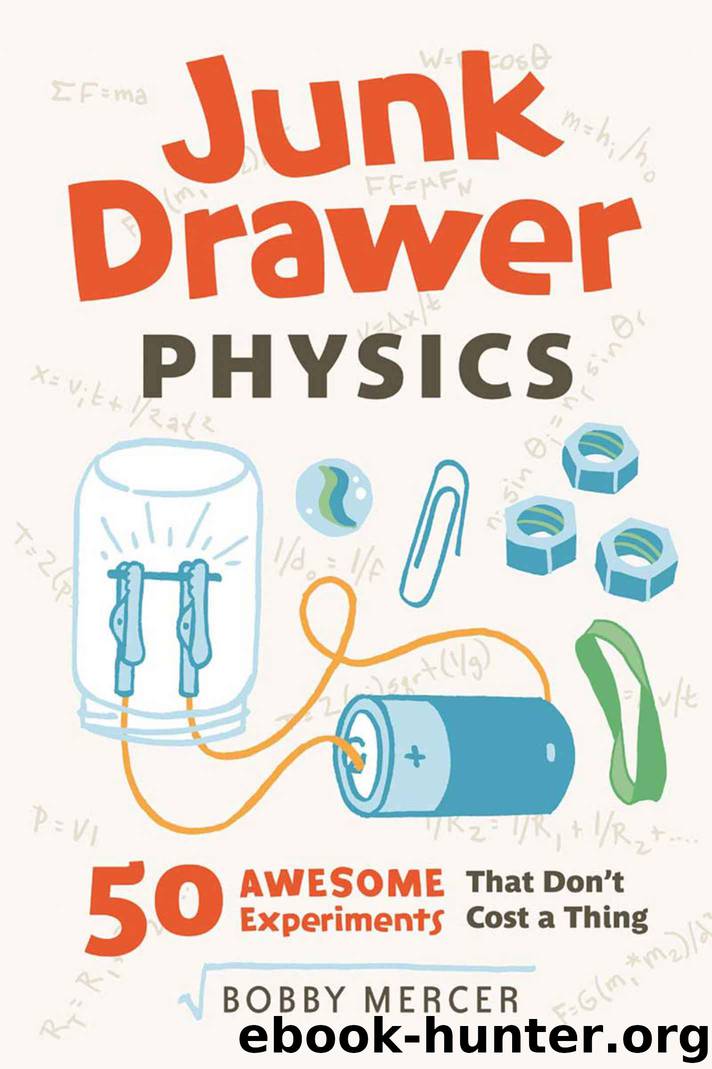Junk Drawer Physics: 50 Awesome Experiments That Don't Cost a Thing (Junk Drawer Science) by Bobby Mercer

Author:Bobby Mercer [Mercer, Bobby]
Language: eng
Format: azw3
Publisher: Chicago Review Press
Published: 2014-06-01T04:00:00+00:00
Step 6: Slide the smaller tube into the larger tube and you are ready to use your telescope. Hold the large tube with one hand and the small tube with the other. Aim your Star Gazer at a tree or something off in the distance. Slowly slide the tubes in and out until the object comes into focus. What do you notice about the image? It should be upside-down and larger. Try looking at various things that are different distances away.
The Science Behind It
Refraction is the bending of light as it passes through a new material. As light from a distant object passes through the first lens, it is bent. When it passes through the second lens, it is bent again. With two lenses (magnifying glasses), you have created a refracting telescope.
Light from a distant object passes through the first lens and creates an image. The tree is called the object and what you see is called the image. Images come in two varieties: real and virtual. A real image is an image that is created by light rays and actually appears on a surface (like the inside back of your eye or a movie screen). When you go to the movie theater, what you see on the screen is a real image. When you look at something with your eye, light passes through your lens and creates an upside-down real image on the back of your eye. Your brain flips the image over. So the first image created by the front lens of your telescope is upside-down.
The lens closest to your eye acts like a good old-fashioned magnifying glass. It magnifies the real image created by the front lens. This second image that you see is called a virtual image. Virtual images are what you traditionally see with a magnifying glass. Virtual images are upright and larger, but the only way to see them is to look through the lens. As you look through the eyepiece of your telescope, you see a large virtual image of the upside-down real image from the front lens. The tree appears upside-down. When you use your telescope at night to gaze at the stars, they will be upside-down, and now you know why.
Galileo didn’t invent the telescope. He did make a better telescope and used it to popularize science in his day. He discovered craters on the Moon, Jupiter’s moons, and sunspots. Many people think his study of sunspots contributed to him going blind in his later years.
Download
This site does not store any files on its server. We only index and link to content provided by other sites. Please contact the content providers to delete copyright contents if any and email us, we'll remove relevant links or contents immediately.
The Giant and How He Humbugged America by Jim Murphy(3400)
The Science Book (Big Ideas Simply Explained) by DK(3233)
Harry Potter: A History of Magic by British Library(3003)
The Elements by Theodore Gray(3001)
A Short History of Nearly Everything by Bryson Bill(2632)
Make by Mike Westerfield(2292)
Easy Electronics by Charles Platt(2282)
The Astronomy Book by DK(2117)
The Cat in the Hat by Dr. Seuss(2109)
CLICK'D by Tamara Ireland Stone(1852)
Science Experiments You Can Eat by Vicki Cobb(1841)
Calling All Minds by Temple Grandin(1782)
Think Like a Rocket Scientist by Ozan Varol(1781)
The Crime Book (Big Ideas Simply Explained) by DK(1758)
03 The Prophet of Yonwood by Jeanne DuPrau(1753)
Minecraft by Mojang Ab(1745)
Pax by Sara Pennypacker(1727)
Martin Gardner's Science Magic by Martin Gardner(1689)
Getting Started with Soldering: A Hands-On Guide to Making Electrical and Mechanical Connections by Vinck Marc de(1661)
